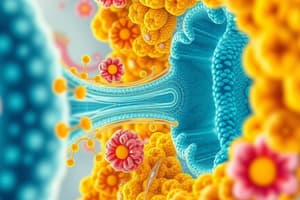Podcast
Questions and Answers
Which type of membrane protein is covalently linked to lipids, such as GPI anchors?
Which type of membrane protein is covalently linked to lipids, such as GPI anchors?
- Integral Proteins
- Peripheral Proteins
- Lipid-Anchored Proteins (correct)
- Transmembrane Proteins
Which of the following is NOT a characteristic of the fluid mosaic model?
Which of the following is NOT a characteristic of the fluid mosaic model?
- Dynamic and constantly changing
- Rigid structure with fixed components (correct)
- Lateral movement of lipids and proteins
- Selective permeability
Which of the following molecule types is NOT a major component of the lipid bilayer of cell membranes?
Which of the following molecule types is NOT a major component of the lipid bilayer of cell membranes?
- Nucleic Acids (correct)
- Sphingolipids
- Sterols
- Glycerophospholipids
What is the main role of cholesterol in the cell membrane?
What is the main role of cholesterol in the cell membrane?
Which of the following statements is TRUE about lipid rafts?
Which of the following statements is TRUE about lipid rafts?
Which type of transport across the membrane is NOT energy-dependent?
Which type of transport across the membrane is NOT energy-dependent?
What is the primary function of pumps in membrane transport?
What is the primary function of pumps in membrane transport?
Which type of active transport system moves sodium ions out of the cell and potassium ions into the cell?
Which type of active transport system moves sodium ions out of the cell and potassium ions into the cell?
What is the primary function of Na+/K+ ATPase?
What is the primary function of Na+/K+ ATPase?
Which of the following correctly describes symporters?
Which of the following correctly describes symporters?
What role do V-Class pumps play in the cell?
What role do V-Class pumps play in the cell?
During glycolysis, what is the net gain in ATP per glucose molecule?
During glycolysis, what is the net gain in ATP per glucose molecule?
What is produced during beta-oxidation of fatty acids?
What is produced during beta-oxidation of fatty acids?
Which process primarily occurs in the thylakoid membrane during photosynthesis?
Which process primarily occurs in the thylakoid membrane during photosynthesis?
What intermediate molecule is formed in pyruvate oxidation?
What intermediate molecule is formed in pyruvate oxidation?
In the action potential, what is the result of the opening of Na+ channels?
In the action potential, what is the result of the opening of Na+ channels?
Flashcards
Fluid Mosaic Model
Fluid Mosaic Model
Describes the plasma membrane structure as a fluid combination of lipids, proteins, and carbohydrates.
Plasma Membrane
Plasma Membrane
A semi-permeable barrier composed of a lipid bilayer, proteins, and carbohydrates that regulates substance movement.
Integral Proteins
Integral Proteins
Proteins that span the entire lipid bilayer and are involved in transport and communication.
Passive Transport
Passive Transport
Signup and view all the flashcards
Active Transport
Active Transport
Signup and view all the flashcards
Lipid Bilayer
Lipid Bilayer
Signup and view all the flashcards
Endocytosis
Endocytosis
Signup and view all the flashcards
Uniporters
Uniporters
Signup and view all the flashcards
Symporters
Symporters
Signup and view all the flashcards
Na+/K+ ATPase
Na+/K+ ATPase
Signup and view all the flashcards
Action Potential
Action Potential
Signup and view all the flashcards
Glycolysis
Glycolysis
Signup and view all the flashcards
Citric Acid Cycle
Citric Acid Cycle
Signup and view all the flashcards
Light-Dependent Reactions
Light-Dependent Reactions
Signup and view all the flashcards
Calvin Cycle
Calvin Cycle
Signup and view all the flashcards
Study Notes
Biomembrane Structure
- Plasma membranes (PM) are composed of lipid bilayers, proteins, and carbohydrates
- They act as a semi-permeable barrier, controlling substance movement
- The fluid mosaic model describes lateral movement of lipids and proteins within the membrane
- Membrane proteins are categorized as:
- Integral (transmembrane): Span the bilayer
- Peripheral: Attached via non-covalent interactions
- Lipid-anchored: Covalently linked to lipids (e.g., GPI anchors)
- Lipid bilayers have hydrophilic heads facing outward and hydrophobic tails inward
- Cholesterol regulates fluidity and stability
- Membrane lipids include phospholipids (e.g., phosphatidylcholine, phosphatidylserine), sphingolipids (e.g., sphingomyelin, glycolipids, ceramides), and sterols (e.g., cholesterol, phytosterols)
- Membrane asymmetry exists with different lipid compositions in cytosolic vs. extracellular leaflets
- Lipid distribution is regulated by flipases, floppases, and scramblases
- Membranes exhibit self-sealing and fusion properties, facilitating vesicle formation, endocytosis, and exocytosis
- Lateral diffusion allows lipids and proteins to move within the membrane
- Phase transitions (gel to fluid state) depend on temperature
- Lipid rafts are specialized regions enriched with cholesterol and sphingolipids for signaling and trafficking
Transmembrane Transport of Ions and Small Molecules
- Pumps (primary active transport) use ATP to move molecules against gradients
- Channels allow specific ion passage down electrochemical gradients
- Transporters (carriers) undergo conformational changes to move molecules
- Transporter types include:
- Uniporters: Transport a single molecule down its gradient (e.g., GLUT1 for glucose)
- Symporters: Move two molecules in the same direction (e.g., Na+/glucose symporter)
- Antiporters: Move two molecules in opposite directions (e.g., Na+/H+ exchanger)
- ATP-powered transport proteins include:
- P-class pumps (e.g., Na+/K+ ATPase, Ca2+ ATPase)
- V-class pumps (acidify organelles)
- F-class pumps (ATP synthase)
- ABC transporters (multidrug resistance, CFTR)
- Resting membrane potential is approximately -70 mV, maintained by Na+/K+ ATPase and K+ leak channels
- Voltage-gated ion channels open/close in response to voltage changes (e.g., Na+, K+, Ca2+) for action potentials
Cellular Energetics
- Aerobic respiration uses O2 as the final electron acceptor in the electron transport chain
- Anaerobic respiration uses alternative electron acceptors (e.g., sulfate, nitrate)
- Cellular respiration's overall equation: C6H12O6 + 6 O2 → 6 CO2 + 6 H2O + 30-32 ATP
- Stages of glucose oxidation include Glycolysis (cytoplasm), Pyruvate oxidation (mitochondrial matrix), Citric Acid Cycle (TCA cycle), and Electron Transport Chain & Oxidative Phosphorylation
- Lipid oxidation (beta-oxidation) breaks down fatty acids into acetyl-CoA, NADH, and FADH2
- Protein catabolism deaminates amino acids, allowing them to enter the TCA cycle
- Photosynthesis involves light-dependent reactions (split water, producing O2 and protons, reducing NADP+ to NADPH) and Calvin cycle (fixing CO2 into glyceraldehyde-3-phosphate (G3P))
Studying That Suits You
Use AI to generate personalized quizzes and flashcards to suit your learning preferences.




